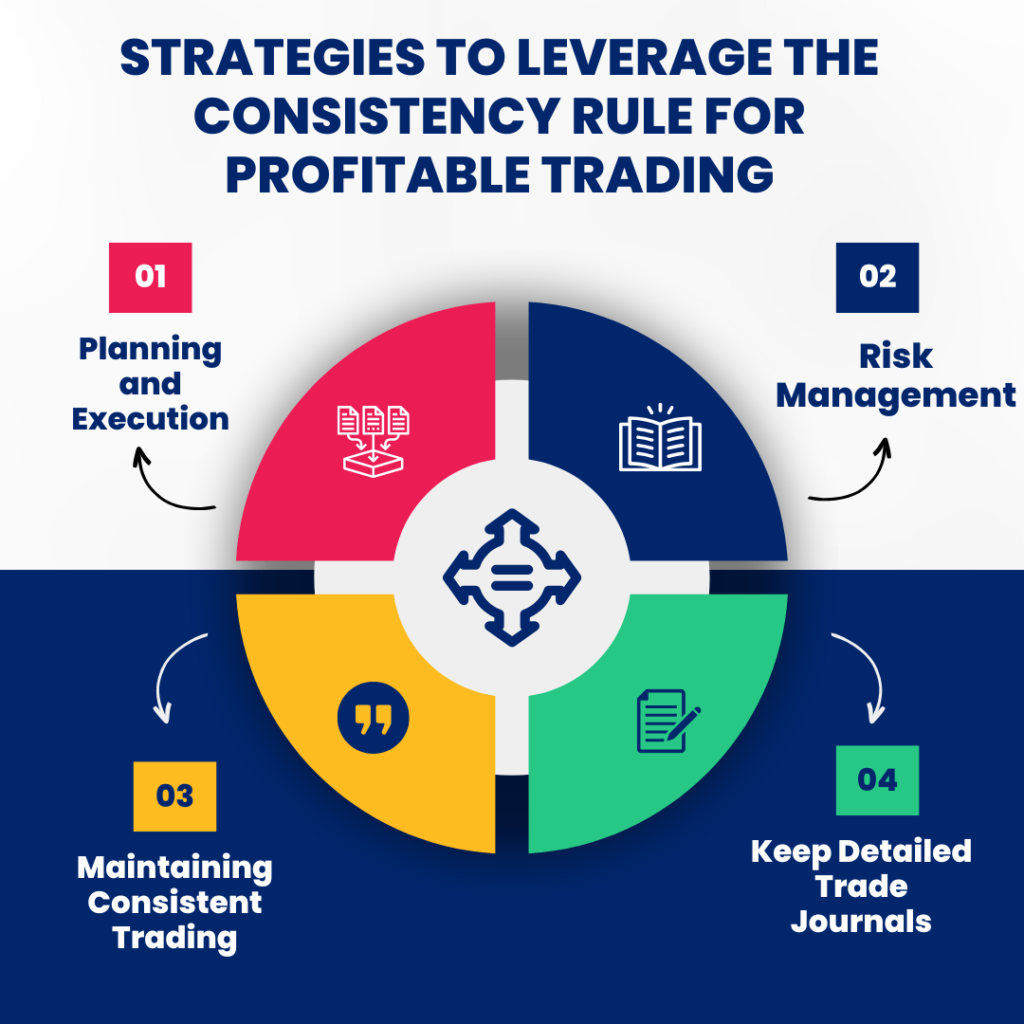- Introduction of Prop Trading's Consistency Rule
- Understanding the Consistency Rule Regulations
- Key Components of the Consistency Rule:
- Importance of the Consistency Rule on Trader Strategy
- The Role of Consistency Rule's Function in Funded Challenges
- Techniques for Using the Consistency Rule to Your Advantage in Trading
Introduction of Prop Trading’s Consistency Rule
Prop trading firms frequently include rules that traders must abide by in order to guarantee disciplined trading and efficient risk management. The consistency rule, a crucial component of the prop trading environment, is one such criterion.
For a predetermined amount of time, traders must maintain a consistent trading performance according to the consistency rule. This entails steering clear of significant swings in trade amounts, gains, and losses. This rule’s main goals are risk management and the promotion of disciplined trading. By abiding by this guideline, traders demonstrate their capacity to regularly turn a profit while avoiding excessive risk, which is crucial for the risk management of the company.
Key Takeaway Points
- Disciplined Trading & Risk Management: By enforcing consistent transaction sizes and tactics, the consistency rule discourages excessive risk-taking and fosters long-term profitability.
- Maintenance: A steady performance while balancing profitability and stability may prevent traders from taking full advantage of high-reward situations.
- Structured Trading Requirements: To ensure consistent and predictable performance, traders must abide by minimum trading days for withdrawals and trade size limits.
Benefits and Challenges
- Risk Reduction: The rule ensures that traders do not take on excessive risk in pursuit of huge gains, hence protecting the firm’s capital.
- Trader Discipline: It fosters a consistent trading strategy, which promotes long-term success and stability.
- Potential Profit Limitation: Some claim that the restriction restricts a trader’s ability to capitalize on high-reward situations, potentially reducing overall profit potential.
- Adaptability Challenges: The rule might be difficult for traders who need to respond fast to shifting market conditions because it necessitates a consistent strategy.
Understanding and understanding the consistency rule is critical for traders in prop trading firms that must balance risk management with profitability.
Understanding the Consistency Rule Regulations
The consistency rule outlines various specific criteria that traders must follow. These restrictions are intended to ensure stable trading performance and appropriate risk management.
- Trade Size Limits: Traders must maintain constant trade sizes to avoid substantial volatility. This entails limiting trade quantities within a specified range in order to maintain trading stability and predictability.
- Minimum Trading Days for Withdrawals: Traders must trade for a certain number of days before they can make withdrawals. This criteria ensures that traders perform consistently over time rather than making short-term gains.
Key Components of the Consistency Rule:
Daily Drawdown Limits
- Explanation: Daily drawdown restrictions limit the maximum loss that a trader can sustain in one day. This limit helps to avoid large losses that could imperil the trader’s account and the firm’s capital.
- Clarification: If the daily drawdown limit is set to 5%, the trader must guarantee that their losses do not exceed 5% of their account amount on any one day.
Trading range requirements
- Explanation: Traders must operate within a predetermined trading range, which specifies the minimum and maximum deal sizes that can be executed.
- Clarification: This component guarantees that traders do not take on excessively large or tiny positions, promoting a balanced approach to trading.
Average Lot Size Calculations
- Explanation: The consistency rule frequently involves computations for average lot sizes, which require traders to keep their average position size within a certain range.
- Clarification: This means that over time, the average size of deals made by the trader should fall within the set limitations, promoting trading consistency.
Understanding these standards and major components is critical for traders seeking to comply with the consistency rule, which ensures disciplined trading procedures and adequate risk management inside prop trading organizations.
Importance of the Consistency Rule on Trader Strategy
The consistency rule has a huge impact on how traders create and execute their strategies within prop trading organizations. Here are a few important characteristics of its impact:
- Risk Management:-
The guideline requires dealers to use severe risk management procedures. Limiting transaction sizes and daily drawdowns forces traders to carefully plan their deals and avoid taking on too much risk, resulting in a more steady trading strategy. - Profit Limitations:-
The rule limits prospective profits, which affects trader earnings. While it protects against huge losses, it also limits the opportunity to capitalize on high-profit opportunities, thus reducing overall revenues. - Trading Style modifications:-
To comply with the consistency rule, traders must make the appropriate changes to their strategy. This could include decreasing trade sizes, following stringent risk management rules, and maintaining a consistent trading strategy regardless of market conditions.
Case Study: A Real-World Example of Navigating the Consistency Rule
Consider Jane, a trader with a prop Trading firm known for its strict consistency guidelines. Jane had to make considerable changes to her trading technique. Initially, she focused on high-risk, high-reward deals, but the consistency rule forced her to take a more balanced approach. She began employing tight risk management procedures to ensure that her daily losses did not exceed the firm’s limits. Jane effectively navigated the consistency rule by maintaining consistent trade sizes and focused on steady, lesser earnings, exhibiting stable performance and eventually meeting her trading objectives within the firm’s parameters.
The Role of Consistency Rule’s Function in Funded Challenges
A crucial element of the many stages of financed problems in prop trading firms is the consistency rule. As traders reach real funded accounts, its use shifts, but it still guarantees that traders keep a steady and disciplined trading strategy during the evaluation and verification stages.
During Funded Challenges application
Traders must show that they can sustain steady trade sizes, profits, and losses during the first assessment stage. This stage evaluates a trader’s ability to follow the consistency rule in testing scenarios. The consistency criteria is still applied at the verification stage to guarantee that the trader’s performance stays consistent and trustworthy. The trader’s discipline and risk-management abilities are put to the test once more during this phase. The consistency requirement is typically loosened or not enforced to live funded accounts after a trader passes the evaluation and verification stages. At this point, actual trading performance and profitability become the main focus.
Assessment of Consistency Rule Compliance
Prop businesses have particular techniques to assess if the consistency rule is being followed, and breaking it can have serious repercussions. To make sure traders are following the consistency rule, firms keep an eye on trade quantities, frequencies, and patterns. Automated algorithms frequently highlight trading conduct that deviates from the norm. To monitor a trader’s compliance with the consistency rule, regular performance reports are produced, pointing out any discrepancies in trade sizes, gains, and losses. A trader’s actions are reviewed through periodic risk management audits to make sure they are disciplined and not taking on too much risk.
Consequences of Non-Compliance
Traders that violate the consistency rule may be subject to warnings or sanctions, which can include financial penalties or temporary trading limitations. Traders may be excluded from the financed challenge in extreme circumstances. The trader’s participation may be terminated if they violate the consistency rule, which may be interpreted as a sign of a lack of discipline and risk management. In order to increase their adherence to the consistency criterion, certain prop firms could mandate that traders who are not complying receive further training or retraining.
Techniques for Using the Consistency Rule to Your Advantage in Trading

Despite its limitations, the consistency rule can be applied to improve trading tactics and guarantee successful results. The following are some efficient methods for utilizing this rule:
Organizing and carrying out
Planning well is essential to following the consistency rule. To prevent large swings, traders should determine acceptable daily gains and create reasonable profit goals. Traders can make sure that every trade complies with the consistency rule requirements and the overall strategy by preparing their trades with these constraints in mind.
Efficient Risk Control
Stable trading performance requires risk management strategies that adhere to the consistency rule. To distribute risk among a variety of assets and markets, traders should diversify their holdings. Furthermore, stop-loss orders can assist in limiting possible losses by making sure they remain within reasonable bounds and preventing them from endangering the trader’s account or the company’s capital, stop-loss orders can assist manage possible losses.
Maintaining Regular Trading
Traders should concentrate on discipline and long-term strategy in order to continue consistent trading without giving in to the lure of high-profit, hazardous deals. Steer clear of high-reward possibilities that could result in large losses. Rather, adhere to a clear trading strategy that emphasizes gradual, incremental gains. Maintaining consistency and following the rule can also be facilitated by routinely evaluating and modifying the trading plan in light of performance and market conditions.

